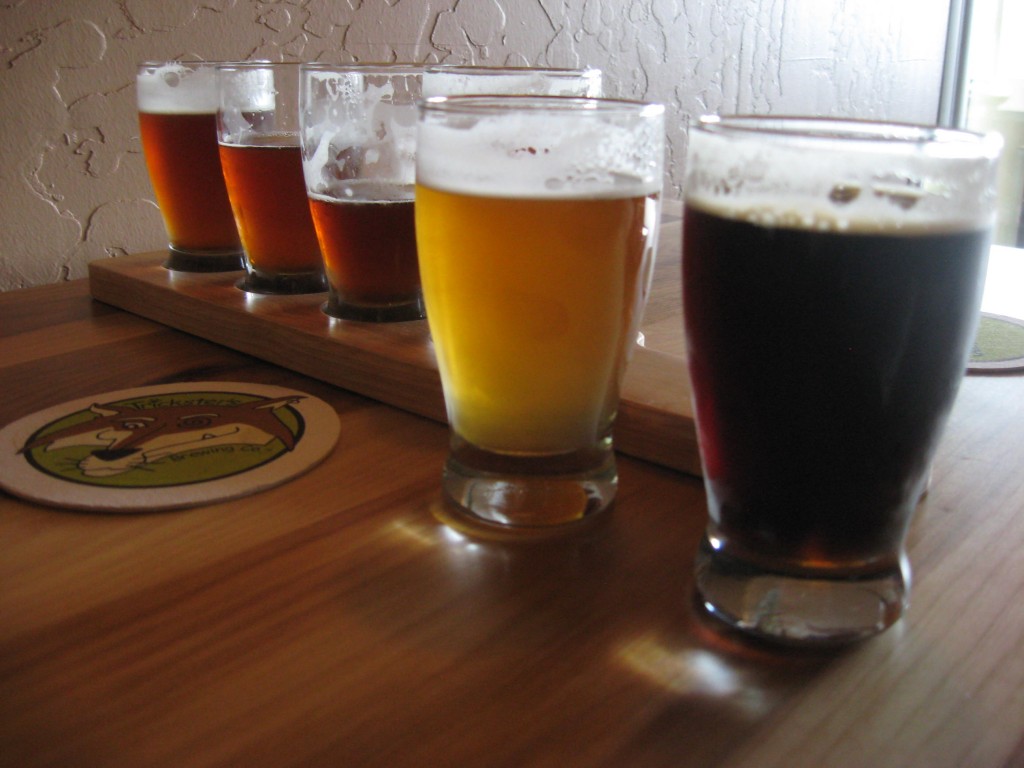
Ken Grossman (rear) & Charlie Papazian (front) mesmerized by swirling wort on its way to
becoming second in Sierra Nevada’s 30th Anniversary beer series, Charlie, Fred & Ken’s Imperial Helles Bock. Photo courtesy Sierra Nevada Brewing Co.
Written by Charlie Papazian for Examiner.com
Stylistically speaking, the just released Collaborative Sierra Nevada 30th Anniversary Beer is different. Pioneer and original homebrew guru Fred Eckhardt, from Portland, Oregon, Ken Grossman, founder and president of the 30 year old Sierra Nevada Brewing Company, the brewers at Sierra Nevada and myself collaborated to decide what we would brew that represented the pioneering beer spirits each of us have been involved in.

Photo (left): Charlie and Fred love to collaborate everytime they get together.
I had recently brewed an interesting and very complex golden/amber lager using malt from a Czech maltster using traditional floor malting methods. Unusual specialty malts were added for unique aroma, flavor and a nontraditional amber character. I wanted to pursue a direction that paid tribute to traditional brewing, malting, fermenting and hopping methods. Ken and the brewers at Sierra Nevada wanted to provide added value and a “thank you†to their customers with an elevated alcohol content that would add complexity and enhanced stability to the beer.
Using my 5.5% alcohol by volume (abv) homebrew recipe for a Czech-American style “amber-Helles†floral hopped lager we ramped up the recipe to 8.3 % with uniquely American techniques and blends of international hops, malt and yeast.
Water: In an attempt to develop typical pilsener smoothness and unique hop characters, very soft water was maintained during the brewing process.
Yeast: Several batches were made using two lager yeasts; Sierra Nevada’s “house†lager yeast and my lager yeast I have been using in most of my homebrewing for the past (available as “Cry Havoc” Yeast through White Labs) 27 years. Sierra Nevada’s house lager yeast helped with attenuation or in other words more complete fermentation. My lager yeast contributes subtle and pleasant sulfur-like character reminiscent of fresh baked bread. At bottling, the beer was “backpitched†with both yeasts added to the bottles for better flavor stability and contribution to a comforting and sensual bready flavor and aroma. Primary fermentation was pursued at temperatures between 52 and 56 degrees F. Lagering was done for a few weeks at lower temperatures.
Malt: About 50% of the base malt was Czech (Bohemian) floor pilsener malt. The other half was large batch European pilsener malt typically used in many pilseners. Also used was about 3% Belgian aromatic malt and 3% Canadian honey malt. The aromatic malt adds significant amber color along with mild, yet notable bready/toasted fresh out of the oven sweet malt aromas and flavors. Honey malt contributes a bit more color along with a very pleasant and subtle floral honey aroma and flavor.
Hops: A very unique blend of hops for bittering, flavor and aromatic character was used. American and unique late and dry hopping techniques were involved in infusing the unique characters of hops. New Zealand Pacific Hallertauer hops were used for the bittering and long boil addition to the brew. A blend of German Tettnang and German Spalt Select were used during the latter stage of boiling for flavor and aroma. The brews were dry hopped during lagering with a 60/40 blend of American Crystal hops and German Hallertauer using Sierra Nevada’s unique recirculating “torpedo†method.
The hops were specifically chosen to contribute floral and sweet hop aromatics and flavor, with a smooth, gentle, yet very satisfying bitterness. Specifically avoided were popular American fruity and citrus-like hops such as Cascade, Centennial, Simcoe, Amarillo, Citra, Columbus. The hops that were used were chosen to dynamically and symbiotically compliment the deliberately infused malt characters. Final hop bitterness is about 41 bitterness units.

This brew is not a knock-your-socks-off hop and alcohol punch. It’s different direction taken than most other American craft made specialty beers. For one, it is a lager. With the unique hop varieties used for flavor, aroma and dry hopping it attempts to take the beer drinker in new directions; a theme which pioneer American brewers have been pursuing for 30 years.
I project that the beer freshly available will have a bit more hop bite, but in a few short months of appropriate cellar aging at cool and stable temperatures the intricate designed relationships between malt and hops will develop – exquisitely. With a year’s aging at about 50 degree F cellar temperatures hop floral and aromatic notes will begin to subside, while malt character may elevate. The beer will take on unique and undetermined directions, surely to remain interestingly delicious.

Finally, you might be wondering why the label says “Ale.â€Â In some states such as Texas, there are arcane laws that define any beer over a certain percent alcohol as “ale†and must be labeled such. That’s why sometimes you see such oddities labeled lager ale. Go figure…
Enjoy. Best served in brandy-like “globed†stemmed glass at about 45 degrees F. Pint shaker glasses are not a good choice of glassware for this brew.
Photo right: Some recommended glassware for maximum enjoyment of Charlie, Fred & Ken’s Imperial Helles Bock. Photo courtesy of American Homebrewers Association
